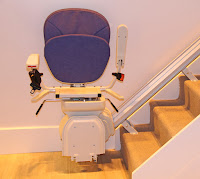Whether you're in your early 60s or entering retirement, there's a good chance you'll want to age in place. That means remaining in your home and modifying it as needed to accommodate any physical changes that come with aging and increase safety for senior living.
Unfortunately, your home may need to be modified for several reasons, including changes to your vision, hearing, and mobility. For example, going up and down the stairs could become more difficult, or you may find yourself fumbling for the light switch more often.
Luckily, you can make many simple modifications to your home to ensure a safe and comfortable environment for years to come! In this article, we will list some essential home modifications for aging in place.
While some of these changes may seem small, they can have a significant impact on your quality of life. We've put together a list of five home modifications every home should have to accommodate aging in place.
 | ||
| Grab bars and Walk-in tub |
The first modification you should consider is installing grab bars in your bathroom. As we age, our balance can change, and it can become more challenging to stand up from a sitting position. Grab bars provide excellent support and stability for getting in and out of the shower or bathtub and can help prevent dangerous falls and injuries.
Grab bars are also relatively inexpensive and easy to install. You can find them at most home improvement stores or order them online.
Raised Electrical Outlets
Another substantial modification is to install raised electrical outlets. It can become more difficult to bend down and reach for things on the floor due to changes in mobility.
Raised electrical outlets make it easier to plug-in appliances and electronics and help prevent falls. They are also safer because they reduce the risk of electrical shock.
 |
| Stair Lift |
If your home has stairs, another modification is installing a stair lift. Stair lifts provide a safe and easy way to get up and down the stairs and can significantly improve your mobility if you have difficulty climbing stairs.
Stairs are dangerous for seniors and can be very difficult to navigate if you have limited mobility. A stair lift can give you the independence to move around your home without fear of falling.
Walk-In Tubs
Another modification to consider is installing a walk-in tub. Walk-in tubs are designed for people with limited mobility and can make bathing much safer and more accessible. Walk-in tubs also have a lot of beneficial features, such as built-in seats, grab bars, and non-slip surfaces. They are an excellent investment for anyone looking to age in place. They're also excellent for hydrotherapy and can help with pain relief. They're also easy to clean and maintain. Although they may be expensive, they are worth the investment.
Ramps
Finally, you may also consider installing a ramp if you have steps leading into your home. Ramps help provide an easy way to get in and out of your home and can help prevent falls. Depending on your needs, you can place them either inside or outside your home. There are many different types of ramps available, so be sure to do your research to find the best one for you.
Wrapping Up
What we listed above is just a glimpse of the many modifications you can make to your home to accommodate aging in place. By making these simple changes, you can ensure a safe and comfortable environment for years to come. Home modifications are meant to help you age in place and live independently for as long as possible. With home modifications, you can help prevent falls and injuries in your house. These changes can also help you save money in the long run. If you're considering making any modifications to your home, be sure to consult with a professional to ensure they are done safely and correctly.
Author Bio David Clark:
David Clark is the CEO of Basement Guides with several years of experience in basement-related problems and home safety. He has written and published many resources and guides related to senior home safety, grants, and home modifications. David is currently working to spread the word about senior home safety and health through resourceful guides and articles.
Thanks David for a great article!
Disclosure: AboutAgingParents.com participates in the Amazon Services LLC Associates Program, an affiliate advertising program designed to provide a means for sites to earn advertising fees by advertising and linking to Amazon.com.
Photos from DepositPhotos.



